Choosing a lens for night photography is an important and tricky decision. I’ve spent a lot of time trying to find the perfect combo to get great shots of the stars. And I’m sure that you don’t want to spend months trying all these lenses so, in this review article, I’ve summed up everything you need to know about choosing the best night photography lens for your camera.
There is a variety of lenses that can be used for night photography. However, each of the lenses has different capabilities and can achieve different results. In this article we will compare two of the most popular Fuji lenses in use, to see which one is better suited for night photography.
I love night photography! Whether it’s infra-red, long exposure, light painting (or –painting with light”) or just enjoying the stars in the sky, there are so many things you can do at night with a camera. Nighttime is when I get my biggest rewards when taking pictures. However, it does require some additional knowledge about what camera and lens to use for certain situations. My aim for this blog post is to provide you with a list of my favorite lenses for night photography and explain why I feel they are the best.
When you think of night photography, what camera do you think of? What camera is best suited for night photography? Well, the answer really depends on how you want to shoot at night. There are many options out there when it comes to cameras and lenses. You can use a Leica M10 and go with just a 50mm lens — or even the kit lens; the tradeoff here would be a shallower depth of field and nice color reproduction. Or you could go for something like an SLR and use a landscape-specific lens like a 14mm f/2.8 or a 14–24mm f/2.8 (like I did in some of my shots) — that would give you more details but also more noise.
Best fuji lens for night photography
Sleeping by the cool light of the moon, dappled in wisps of silvery haze; lonely streets as quiet as a sleeping baby. Taking photographs of nighttime scenes is an interesting and challenging hobby. To capture these beautiful moments you need some specialized equipment, like a powerful tripod and a telephoto lens.
Fujifilm’s largely APS-C-based X Series of digital cameras first appeared on the scene back in 2011 with the Fuji X100 camera, which was, surprisingly enough, a fixed-lens camera. However, in the years following, the X Series has grown to encompass a wide range of camera models, most of which are interchangeable-lens mirrorless cameras. Combining stylish and retro-inspired designs with powerful performance and excellent image quality, Fuji’s X Series nowadays is wide-ranging with a little something for nearly any type of photographer and at almost any budget level.
As one of the largest manufacturers of photographs, we offer a variety of best fuji lenses for night photography designs. Solaroid Energy focuses on providing you with the most stylish and extravagant image that you will ever see on the web. Whether it’s a camera, a camera accessory, or a camera repair, solaroid energy experts search the globe for the best and most unique models. Our collection of unique photographs includes the best fuji lens for night street photography, the best fuji lens for low light, and Fujifilm astrophotography.
With the best designs, values, and styles, we provide the best fuji lens for travel. For photographs, there are many different designs available. Solaroid Energy official website is the best place to shop for the best lens for night photography Nikon. Among the most popular photos on the market are ours. You can find the best lens for night photography on our website. You can choose from a variety of the best lenses for night photography Sony designs available right now. Select your favorite now!
Fujifilm 23mm F2: (Best Fuji Affordable lens for street photography)
I’ll be telling you why I think this is a great little travel lens.
So I’ve owned the 23-millimeter F2 lens for about a year now, and I’ve taken it with me to Jamaica and throughout Europe, and I must say it is one of my favorites.
It’s lightweight and compact; it’s affordable.
Nice weather sealed and dust resistant, quick and silent autofocus wide field of view, makes it great for travel photography.
It’s also great for videos.
Not optimal when shooting close-ups; there is no image stabilization.
The Fuji 23-millimeter F2 lens is smaller and lighter than other Fuji lenses, making it a more comfortable option for smaller cameras without unnecessary parts and pieces.
The lens is sturdy and feels like it’s been made out of quality material.
The lens hood and cap are both made from plastic or metal lens hoods that can be purchased as extra and replace the plastic ones.
As mentioned before, one of the biggest pros is its convenient size; it’s small and compact, which makes it an ideal javelin that attaches easily to your camera without adding any unnecessary extra ball; the lens weighs just 180 grams.
So it’s lightweight, as well, which makes carrying it with you while in busy city streets, all day a breeze.
Now on to the good stuff, how good are the images taken by this lens? That’s the most important thing.
I’ll be breaking this down into smaller sections. One is the lens autofocus and the lens sharpness, and I’ll go more in-depth into these sections now.
The 23-millimeter lens autofocus, so the autofocus on the 23-millimeter lens is one of its best features, is exceptionally quick so that you can snap moments in a heartbeat.
And it’s silent, a big plus for street photographers’ sharpness.
The lens has fantastic central shorteners, but it starts to fade a little in the corners.
This isn’t often a major issue for street and travel photographers, though, and sometimes isn’t even that noticeable.
If you play around with the stops, you’ll find the ideal shortlist for your subject most of the time.
The 23-millimeter lens is actually incredibly affordable; it’s much cheaper than other Fujifilm lenses.
The lower price makes it an excellent traveler for beginners since you’re not investing in large amounts of money while you decide if photography is a hobby or a career for you.
This is small and affordable and is compatible with all Fujifilm X series; interchangeable camera systems are perfect for beginner photographers, ideal for Vloggers, and are a must-first street photographer.
It will have you itching to get outside and snap photos of people’s buildings and opportune moments.
The free build is also perfect for throwing into a backpack and taking on adventures.


Pros
- Solid build quality.
- Lightweight & compact.
- Quick and silent autofocus
- Excellent crisp optics.
- Less distortion.
- Weather-sealed and dust-resistant.
- Very affordable in price.
Cons
- No image stabilization.
So when the Fuji 16-millimeter F2.8 was announced, I was pretty excited to get my hands on it and see what it was all about.
The 16-millimeter actually comes in an F 2.8 to keep the size under control, but for all intents and purposes, this little guy is definitely part of the same family, so I’m going to call it a Fuji cried, even if it is F 2.8, and you can’t stop me.
In terms of specs, the 16-millimeter f 2.8 is an APS-C lens with an equivalent field of view of 24 millimeters on a full-frame body.
The design weatherproof lens is made of 10 elements and 8 groups, including spherical elements.
I use this Fuji Super EBC coating for outstanding optical performance.
It’s got a maximum aperture of F 2.8 for low-light shooting.
In terms of build quality, this lens is on par with any other Fuji X lens.
It’s got a metal barrel and lens mount, but it still manages to come in at about 155 grams, like all my favorite Fuji lenses.
It has a dedicated aperture ring with one-third stop increments all the way around.
Alright, let’s talk about autofocus speed. The lens uses an internal focus system with an ultra-quiet stepping motor.
I haven’t hooked this up to any high-tech measuring equipment or anything, but I can say this little lens is blazing fast as it ranks among the quickest I’ve used on any Fuji lens to date.
So yeah, the AF is fast on this lens, but I’m a street photographer, and any amount of time for ATF to acquire its focus is too long.
Now, this is where it gets interesting with a 16-millimeter lens, I usually shoot it at f8, and with a 16-millimeter lens on an APS-C body at f8, the hyperfocal distance is between 5 and 6 feet.
Yes, I wish this lens was perfect in every situation, but the reality is practical to use; softness will never be an issue for me as a street photographer.
What really makes this lens stand out for me is this it is a 16-millimeter lens, a 24-millimeter full frame field of view lens.
And it’s only this big, the fact that he was able to make this lens like this is nothing short of astounding, and having access to the 24-millimeter field of view as a street photographer opens up a ton of creative possibilities.
A 16-millimeter lens on a PSA translates into a 24-millimeter field of view approximately on a full-frame camera.
And that’s an ultra-wide-angle lens.
But is it too wide for street photography? Well, yes and no.
I like first to tell you this lens allows me to shoot in tight spaces like when I go out and shoot Halloween or different events where there are many people.
And I’m shooting inside the crowd, and creating compositions in tight spaces is well unleashed a whole new shooting level.
That wouldn’t be available if I didn’t have a lens like this in my bag, so all in all.
This is an excellent versatile lens for street photography.
So, don’t hesitate if you want this focal length; this is a great choice and for the money.
There’s really nothing else in the market compared to this, so it should be obvious from how I’m going on that I’m a big fan of this lens.

Pros
- Affordable prime lens.
- Lighter & Compact.
- Excellent images.
- Weather-sealed lens.
- less distortion
Cons
- Not stabilized.
I’ve been using Fuji film for roughly four years now, and 56 F1.2 is a lens that keeps getting recommended to me.
I’ve always been interested in trying it out, but I’ve never gotten around to it, and yet it’s given me a major headache on whether to buy this lens or not.
I like using longer focal lengths like 50 millimeters, and 56 millimeters 90 millimeters for street photography.
I know lenses like this are generally used for portrait stuff in studio work.
But when taking street photos, I find it can be a bit more creative when using longer focal lengths rather than wide focal lengths.
I’m just going to share my thoughts on using this lens for roughly three weeks.
So I rigged it in this unit from Fujifilm as I’m still deciding whether to buy this lens or not; I’m going to discuss that in more detail.
So let’s kick things off by talking about some of the things I like about the Fujifilm 56 F1.2, and the main reason I’ll take up a lens like this is to shoot at F1.2.
So what that means is you can get a much shallower depth fulfilled with this lens, and it allows you to be more creative.
When you’re taking photos at night, the images, are a lot cleaner, a lot sharper.
There is a big difference that should have 1.2 at night, which brings me to my second point: image quality.
Now, even at 1.2, the photos taken with this lens are absolutely crisp.
So the 56 F1.2 probably renders the best backgrounds I’ve seen from all the Fujifilm lenses that are the focus areas are creamy, and the bokeh is nice and round, especially at F1.2.
For a lens that is F 1.2 and has so much gloss in it, and it’s so fast, and it’s actually pretty light.
It was nice in hand, especially when you’re out there taking photos, which is what made the metal act during is nice and smooth.
So they’re the main things I like about this 56 F1.2, and now I’m going to talk about some of the things I dislike about this lens.
And the first point, and it’s the main point and this, the main reason which is holding me back from flying this lens is that this 56 F1.2 isn’t water-resistant.
Yeah, I really wish this 56 1.2 at Weber ceiling, because, for me, that would have made it pretty much the perfect street photography lens.
Next up, and it’s not a major point, but it’s the closest focus in the distance for this lens.
So the minimum focusing distance for the 56 1.2 is 70 centimeters.
Now there’s no massive problem when you’re taking photos on the street because it’s a 56-millimeter lens.
You don’t have to brighten people’s faces, so that’s not really a big issue there.
So there is that; it definitely is slower, so it’s something you have to watch out for.
If you’re taking photos of falsely moving subjects, this may not be the lens for you.
But I will say that this lens actually made me want to go out and take photos, which I can’t say for many other lenses I’ve ever used.
And I really liked the photos which came out of it. I highly recommend this lens.
When I first bought this lens, I put it on the camera straightaway when I walked out of the shop, which is the first photo I took. It made me think; that this is definitely a street photography lens.
56-millimeter F 1.2 is basically an 85-millimeter equivalent, giving you that nice telephoto portrait kind of field of view, which I find excellent for street photography.
It’s well known to be a slow lens because it’s pretty bulky and big.
It allows me to keep that low profile of being on the street.
And having that telephoto range allows me to get nice shots that are not in anyone’s face, not in anyone’s way.
But still focusing on that moment and really framing in on what’s happening in that urban environment.
Sharing that urban story which, in my subjective opinion, is what street photography is about.
It doesn’t have to be on the street but really share that story of the environment that you live in, share the city, or wherever you live to share that with the world and let them know what it feels like to be there.
I also love this lens for videography.
F1.2, with a 56 millimeter gives you a nice dynamic visual that you can actually feel like you’re there.
Feels close, brings it all together, and ties in everything nicely, and obviously, for portraits, this length kills it.
Let’s be honest; I bought this lens with my own money for 1.2 low light. It just makes everything come together.
Every lens has its pros and cons.
I find that bringing something new to the table brings that low light capability, brings in that stealth lift where you can; you don’t have to be so close and focus on something, getting a new look very unique.

Pros
- Extremely sharp.
- Less distortion.
- Best for portraits.
- Best for low light conditions.
Cons
- Slow to focus.
- No image stabilization.
- No weather-resistant.
This is one of my favorite lenses; I use it all the time, in forestry travel photography, and commercial work.
So the first thing I’m going to say is that 50-millimeter lenses are normally used for street photography.
So you have to remember, this is 50 millimeters on a Fujifilm camera, which uses APS-C sensors, so, on full-frame.
This 50-millimeter lens is actually 75 millimeters.
Now, a 75-millimeter lens or 50-film case is very rarely used in street photography.
If you look at the most famous street photographers, those guys will use 23 millimeters, 35 millimeters, or 50 on a full frame.
I just like the range it gives you so when you are inside the pulse of the city.
You don’t actually want to get up in people’s faces, nor do you want to sometimes disturb people from their day-to-day lives by getting in their faces with a wide-angle lens.
So instead, a lens like this allows you to get close to your subject without actually physically getting close to them.
Also, it allows you to get more separation between your subject and the background, which in my opinion, mixed with better photos.
So, let’s talk about some of the things I like about this lens, and the first main reason I picked this up in the first place is just how small and lightweight it is.
Furthermore, so whenever I hit the city, I can spend between seven hours just walking around taking photos.
So yeah, the size of this makes it absolutely excellent for street photography.
Next up is water resistance.
I love taking photos in the rain; it was one of the main reasons I picked up a Fujifilm camera in the first place.
It makes them fully water-resistant, and I’ve literally put that to the test in some intense conditions.
So, I’ve been in the mountains where there’s been trying rain and thunderstorms going on, or just walking around London nonstop in the rain, and I’ve never had a single issue.
So yeah, the water resistance definitely works on Fujifilm.
Image quality-wise, I have no complaints, especially when you look at the size and weight of this spin.
I use it for commercial work for portraits through photography travel, and I never really had an issue with the quality.
For autofocus, I almost always use autofocus for street photography, and I can’t remember ever missing a subject or missing a moment to slow autofocus.
So no complaints in that department are negative I can finger regarding this lens, and it’s the same with the F2 lenses, which is the manual focus.
So if you primarily manually focus, this lens may not be for you, and that’s because all the focus is done electronically.

Pros
- Small, lightweight & compact
- Extremely sharp.
- Less distortion.
- Dust & splash water resistance.
Cons
- No image stabilization.
The Fuji film 27-millimeter pancake lens.
What I like about this lens, first and foremost, is its size; I got this lens for the compact size and punched that it packs with small but great features.
This lens actually gets down to 2.8, which is quite incredible for a lens that small and for that little glass.
There’s just something about grabbing your camera and getting on the road and going out and choosing some great photography, and that’s what I love about Fuji’s fantastic color with a simple setup.
This lens with video captures some great colors and even some good depth of field for such a small lens.
So like I said if you’re looking to get out on the road, shoot some great street photography.
This lens cannot be wrong and packs a punch-in, small package.

Pros
- Small, lightweight & compact.
- Extremely sharp.
- Best for video.
- Amazing colors & contrast.
Cons
- No image stabilization.
- No weather sealing.
I repurchased it in 2015.
It weighs 10 and a half ounces, takes 62-millimeter filters, and equals a 35-millimeter focal length framework.
This lens has no optical image stabilization, is not weather-sealed, has no fancy nano-coating, and is equipped with a pretty outdated autofocusing more on the price tag.
But for me, 23 1.4 is still one of the best Fujifilm Prime’s.
I’ll tell you why I think that’s the case.
Let’s start with the build quality.
The body is made out of metal, which guarantees resistance to most forms of abuse, and high copies definitely prove that.
You won’t find any cheap plastic on it; all materials are of top-notch quality.
Well, it’s lighter than any other fast aperture lens; the aperture ring it’s quite a bit too smooth for my liking.
If you pull the focusing ring towards you, the lens goes into manual focus.
This is a super clever feature, and I believe only two other Fujinon lenses offer this option.
Some people might find this annoying, but for me switching this way between AF and MF mode.
Another feature available only on these three lenses is engraved depth field marking, which I find extremely helpful for manual focusing operation.
The lens produces very rich and smooth bokeh out-of-focus area apertures between 1.4 and 2.8, capable of delivering truly great results.
The subject separation is well-controlled, and there are no signs of background business, even in high-contrast areas.
In conclusion, I must say that a 35-millimeter focal length or field of view, if you like, is by far my favorite.
I believe this is an excellent 23 1.4 that fits a wide range of styles from street portraiture and environmental landscape, or it can be just used as a general-purpose lens.
23 1.4 sharp contrast and it renders colors absolutely beautifully.
And on top of that performance, for me, an extra stop of light is super important, especially when shooting in low light conditions and build quality. It’s absolutely exceptional.
And this might be the main reason why I picked this one.
I think its potential is later on in the build construction and the quality ergonomics of this lens are bar none, just really, really great.
Moreover, I really like this lens because it has 16 millimeters, and it’s the clutch system for going from auto to manual.
I really liked that clutch override, like when you click it.
You’re automatic, and you can go to manual by just pulling that down on the lens, you don’t even have to touch the switch on the side of the camera; the focusing ring is super smooth.
The image quality on this lens is really excellent.
I found that there’s a tiny bit of blurriness on the edges, and when I’m way down at F-16, I can get a tiny bit of diffraction, not a lot, but it is there.
And personally, in my case, it’s just negligible, especially for the reasons I have this lens, and that is frustrating because what this lens does do that’s fantastic is its capacity to show the contrast between different colors.
The color contrast is unbelievably incredible; you say to yourself, well, color contrast doesn’t really matter because when I’m going to be shooting in black and white from street photography.
Also, bokeh is super nice, and when I do go out and shoot a bit of street, I like to open up and get a bit of blur in the background.
So overall this lens is that it’s perfect. I would suggest that to anybody doing street photography.
To me, the 23-millimeter focal length, full Frame 35-millimeter equivalent.
There’s nothing better in terms of focal length. You can’t ask for a better focal length to go out and do some great Street.

Pros
- Solid optical performer.
- Extremely sharp.
- Best in the low-light situation.
- Autofocus is fast.
- Storytelling lens.
- Less distortion.
- Best wide-angle field of view.
Cons
- Some vignetting & distortion.
Is Fujifilm good for street photography?
The Fujifilm cameras are an obvious choice if you’re a street photographer seeking for the finest digital camera for street photography. It’s a stealthy, smart, and feature-packed camera. In street scenarios, the face detection focusing mode is helpful. With an articulated screen, I can shoot in any direction. For better pictures in streets with such a dynamic vibe, image stabilization lessens the impacts of camera shake at long exposures and lens lengths. Portugal is a nation of energetic coastal cities and some of Europe’s most stunning beaches. Fujifilm consistently produces flawless results. My favorite Fujifilm lenses for street photography are listed below.
Is the Fuji xt3 good for street photography?
Yes, the Fuji xt3 is suitable for street photography. The camera is closer to the body when using the viewfinder, allowing the photographer to hold it while taking street shots and reducing camera shake steadily. I can take photos with a live view instead of utilizing the viewfinder, which lessens my invasiveness. When I need to focus on a face on the street, the face detection focusing feature is useful. A bigger APS-C (23.5 x 15.6 mm) sensor, as opposed to a smaller one, assures good low-light image quality and, when required, offers a shallow depth of field and a lovely fuzzy backdrop. It looks like Instagram was built for this Parisian Street. The avenue is lined with vibrant buildings, making it the ideal location to capture a classic Parisian image and add some color to my camera roll. With this beast, I always obtain excellent outcomes.
Is 50mm good for street photography?
The 50mm is the ideal lens for street photography. The lens is flawless in every aspect. It is frequently referred to as the “nifty fifty” or the versatile lens since it has more applications than any other focal length. The ideal lens for individuals who seek excellent results without spending a fortune is the Fujifilm 50mm Lens. This lens is perfect for people who have a Fujifilm digital camera and need an affordable beginner lens. This lens, which has a maximum aperture of F2.0 and is equivalent to 76 millimeters (in the 35-millimeter film format), can create stunning bokeh in any setting. Even when cold outside, other lenses might perform better. I have used this freely for street photography of my clients.
Which lens do street photographers use?
Fujifilm 23mm F2 is the best Fuji lens for street photography that photographers prefer to use. Its affordability, portability, and lightweight design made street photography simple for me. It is excellent for travel photography because of its wide field of view, rapid and silent Autofocus, decent weather sealing, and dust resistance. The 23-millimeter lens autofocus is one of its best characteristics since it is incredibly quick, allowing you to capture moments in a flash. The most colorful street in Paris, Rue Crémieux, is situated in the city’s 12th arrondissement, and I find it ideal for taking my images with this lens for my camera.
Is the xt3 a professional camera?
Yes, xt3 is a professional camera. It’s a really lovely, precise EVF. Fuji additionally reinforced the lens mount and the camera’s base to increase the camera’s longevity. The camera is still weather-sealed, as previously. Overall, the X-T3 is more durable, has better aesthetics, and feels better. As a street photographer, I want clear images with sharp lenses, dependable gear that can withstand some abuse, and a simple workflow for both shooting and post-processing. The business thoroughfare Rue de Rivoli traverses the heart of Paris. Although the stores are a big lure, the captivating views forced me to take professional photos for a cosmetics company.
Is a 35mm lens good for street photography?
A 35mm lens is appropriate for street photography, yes. Due to its numerous benefits in this continually growing field, the 35mm lens is the one that street photographers use the most frequently. The frame is large enough to accommodate many different themes and can easily support both a topic and a backdrop. I have used this lens to execute various duties as a specialist in this field. Lisbon is ideal for a sunny, uncrowded April holiday in Europe. The streets there are a perfect canvas for capturing priceless moments with your loved ones, and the Fujinon XF35mmF2 was the lens that let me catch my ideal setting.
What size lens is best for street photography?
Due to its many benefits in this rapidly developing field, the 35mm lens is the one that street photographers use the most frequently. A topic and a backdrop are readily included in the frame, and it is wide enough to accommodate many subjects. The streets of Turkey are lovely. Turkey’s roads are engineering marvels. I had intended to visit Istanbul’s attractions as soon as I arrived. I noticed an ice cream truck outside at nine o’clock. Turkish ice cream seller who entertains customers by singing and dancing. The famous ice cream of Turkey. The Fujinon XF35mmF2 lens on my vacation camera worked great for casual street photography. Next time, I’ll pay.
What is the best focal length for street photography?
Some of the most common questions that I get from viewers are what lenses I use or what lenses they should get. Obviously, your photography or art style is entirely up to you, and you have to find the right lens for that picture style, but if you’re a beginner, you may not really know where to start. What kind of results could you expect from different lenses and your focal length, so you would have a better idea of what lenses to buy next? And there are too many different camera brands, and I obviously can’t talk about all the lenses on the market.
I’m just going to focus solely on the focal lens, so it doesn’t really matter if you use Canon Fujifilm Nikon Sony DSLR or Mirrorless. Some of the most common focal lengths for street photography are 28 millimeters, 35 millimeters, and 50 millimeters.
Different focal lengths will give you a different look, and in photography, it’s not always about what’s in your frame because the way they look can also add a lot to your storytelling. If you’re starting, the most important thing you have to remember is that any lenses that you get will add to your experience, and it will help you become a better photographer.
So, don’t worry too much about not getting the right lens, or don’t worry too much about the reviews or corner sharpness and things like that; go out there and shoot and enjoy photography.
Best fuji lens for night photography
Much like other interchangeable lens camera systems, Fuji X Series cameras can often be purchased as body-only or as a kit with usually a single zoom lens. If you’re picking up a new Fujifilm X Series camera body, you’ll need to decide what type of lens to buy alongside your new camera or if the kit lens will fit your specific needs. Or, perhaps you’re an existing Fujifilm owner with just a single kit lens setup. You might eventually want to either upgrade this lens as you advance in your photography skills or expand your camera kit with additional lenses to make your photo capabilities more versatile.
Whatever the reason, making a decision on what lens to buy can be a difficult task, with numerous lens options out there. Multiple versions. Different price points. Different zoom ranges and lens designs. With Fujifilm, in particular, there are now well over 30 lenses in the X Series lens lineup that run the gamut from ultra-wide zooms and bright prime lenses to macro lenses and long telephoto zooms…
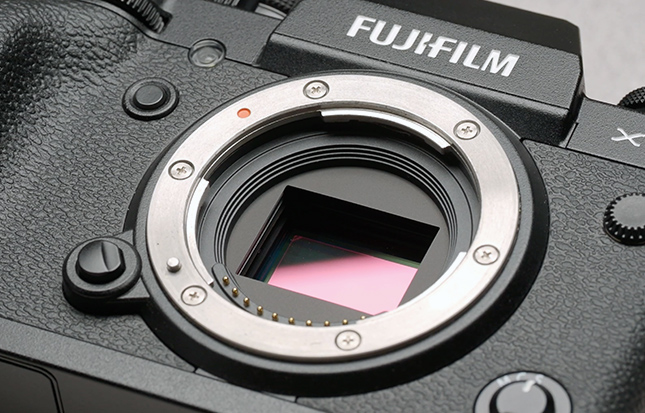
So, what lens should you buy for your Fujifilm camera?
Much like other camera and lens manufacturers, Fujifilm makes a wide variety of lenses at different quality levels and price points. The first thing to consider is what type of images are you looking to create. The other factor to consider is your budget. When looking for the “Best Lens,” it might be tempting to just pick the highest-priced one. Chances are that’ll be a fantastic lens. Truth be told, an expensive lens is often a very good one, too. But, most of us out there, us here at IR included, must keep an eye on our budget. As such, we’ve tried to keep the price in mind when it comes to making lens recommendations in this guide.
For the organization’s sake, we’ve also broken down our lens recommendations below into separate categories depending on the type or style of photography.
Without further ado, if you’re looking to upgrade the lens or lenses for your Fujifilm mirrorless camera, then read on!
Navigation
Use the category links below to jump directly to the specific section:
- Best Fujifilm Lens for Landscape Photography
- Best Fujifilm Lens for Travel & Street Photography
- Best Fujifilm Lens for Portrait Photography
- Best Fujifilm Lens for Sports Photography
- Best Fujifilm Lens for Wildlife Photography
- Best Fujifilm Lens for Astrophotography
• • •
Best Fujifilm Lens for Landscape Photography
One of the key characteristics of a typical landscape lens is a wide-angle or ultra-wide-angle focal length. These types of lenses let you capture more of the scene, which makes them ideal for landscape photography. Imagine a dramatic mountain vista, a wide-open field or a massive waterfall: A wide-angle lens is a good choice for all of these shooting scenarios. Wide-angle lenses are also great for emphasizing a foreground subject. Shoot wide and get in close, and your subject will dominate the frame.
First Choice: Fuji XF 10-24mm f/4 R OIS WR
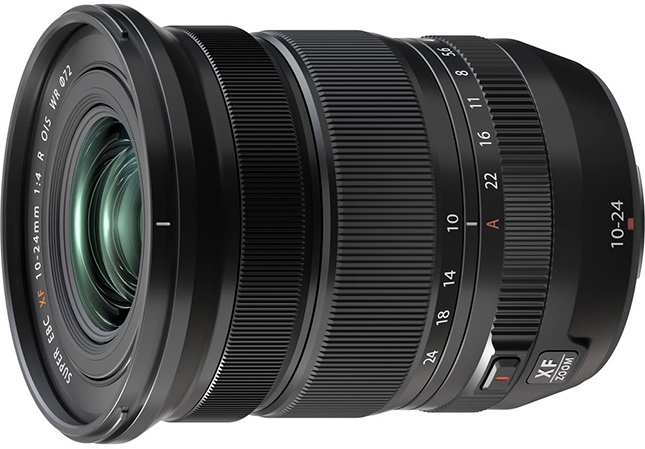
This ultra-wide-angle zoom lens provides a versatile 15-36mm-equivalent zoom range, making it an excellent option for landscape photography pursuits. Fujifilm updated its highly-regarded XF 10-24mm f/4 lens towards the end of 2020, adding improved optical image stabilization, a refreshed design with a labeled aperture ring, faster AF, and, most importantly, rugged weather sealing to its construction.
Optically, the new version of this ultra-wide-angle lens is unchanged, which is a good thing, as the original was already excellent. As we found in our review of the original model, the lens is exceptionally sharp across its zoom range, even when used wide-open. Other issues, such as chromatic aberration and vignetting, are very minimal. Optically, it’s a wonderful lens. The maximum f/4 aperture does make it more suitable for daylight shooting situations, but the on-board image stabilization (as well as IBIS in a handful of modern Fuji X series cameras) can help when the light levels drop — not to mention, also being helpful for handheld video shooting, too.
All in all, the Fuji 10-24mm f/4 WR lens is an all-around solid choice for a landscape-centric lens. It’s small, lightweight, built even better now, and is a top-notch performer when it comes to image quality.
Buy now: Amazon | B&H
Try It Before You Buy It? — Rent this lens from Lensrentals
Upgrade Pick: Fuji XF 8-16mm f/2.8 R LM WR
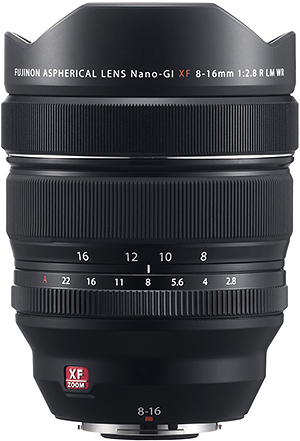
For most landscape photography situations, you usually don’t need a bright-aperture lens. You may be shooting from a tripod or capturing images with deep depths of field. That said, situations do arise where a brighter lens is helpful, especially for low-light shooting and astrophotography/night sky situations. Also, if you want a wider perspective than our 10-24mm recommendation — and price isn’t really a factor — then the Fuji XF 8-16mm f/2.8 WR is a top-of-the-line landscape lens for your Fuji camera.
Offering a super-wide 12-24mm-eq. zoom range, the Fuji 8-16mm f/2.8 lens is capable of capturing dramatic, sweeping landscape photos as well as offering excellent performance in low-light and for night-sky photography thanks to its bright f/2.8 aperture. Optically, the lens is fantastic all around, even wide open, and the lens’ suppression of comatic aberration indeed makes it a great choice for stars and other astrophotography subjects.
The Fuji 8-16mm is an absolutely fantastic landscape lens, if you have the budget — and don’t mind the heavier size and lack of screw-on filter threads.
Buy Now: Amazon | B&H
Try It Before You Buy It? — Rent this lens from Lensrentals
Best Fujifilm Lens for Travel & Street Photography
Picking a lens for travel and street photography can be a difficult task. For street photography, you might lean towards something small, lightweight and discreet, whereas for travel purposes, you’ll likely do well with some zoom versatility. In both cases, though, you’ll probably want to keep your Fuji camera kit as simple and lightweight as possible; in other words, a single-lens setup. Think: walking around on vacation, exploring a new city or going on a hike. Having a light but versatile camera setup is key.
First Choice: Fuji XF 16-80mm f/4 R OIS WR
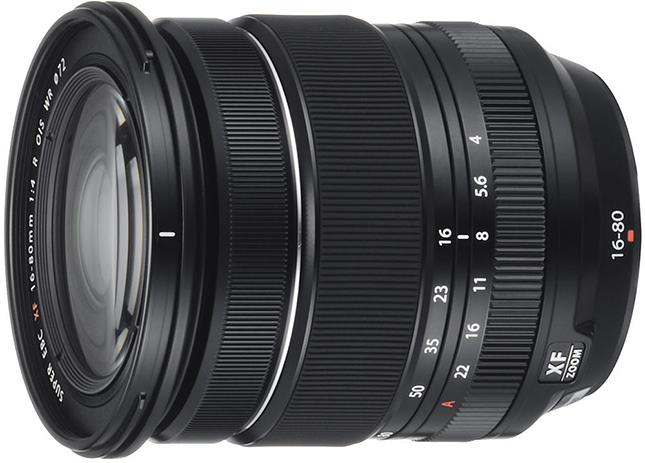
Fujifilm makes a variety of versatile zoom lenses that all do well for the “travel & street” category, but one lens in particular that strikes an excellent balance of compact yet rugged design, sharp image quality and a reasonable price point is the XF 16-80mm f/4 R OIS WR lens. Offering an all-purpose zoom range of 24-122mm in 35mm-equivalence, the XF 16-80mm lens an excellent one-lens choice for a compact camera kit, whether you’re photographing landscapes, street scenes, family vacation moments or impromptu portraits. The lens is weather-sealed, weighs just 440g (under one pound) and has a handy constant aperture that we prefer over variable-aperture lenses.
While we’ve not yet lab-tested this particular lens, we have used it alongside the X-T4 and found the image quality and overall performance to be excellent. The lens is very sharp across the zoom range, even wide open. Further, other user reviews are similarly positive, praising the lens’s image quality, weather-sealing and built-in optical image stabilization, which make the lens a good choice for the several Fujifilm cameras that lack in-body sensor-based stabilization systems.
More zoom range than a kit lens, a constant aperture design, weather-sealing, OIS and a $799 price point make this XF 16-80mm lens an all-around winner for a single-lens travel setup.
Buy Now: Amazon | B&H
Try It Before You Buy It? — Rent this lens from Lensrentals
Upgrade Pick: Fuji XF 16-55mm f/2.8 R LM WR
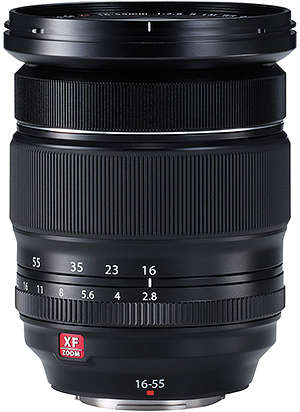
If price or weight is less of a concern, the Fuji XF 16-55mm f/2.8 R WR zoom is a fantastic, versatile lens. Offering a bit less zoom range than our top pick, but in exchange offering a brighter f/2.8 constant aperture, this high-end zoom is the preferred choice if you find yourself shooting in lower light situations more often or if you want better subject isolation and shallow depth of field potential. The image quality, as well, is top-notch, with the 16-55mm f/2.8 lens producing tack-sharp images throughout the zoom range and even at f/2.8. As mentioned, the lens is heftier than our 16-80mm pick at about 655g (1.44 lbs.) and pricier too, with an MSRP of around $1200. But this lens is an absolutely stellar performer.
Buy now: Amazon | B&H
Try It Before You Buy It? — Rent this lens from Lensrentals
Best Fujifilm Lens for Portrait Photography
When it comes to picking a lens for portraiture, you’ll most likely want something with some telephoto reach. Wide-angle lenses, on the other hand, can distort and accentuate facial features in an unflattering way, whereas a longer standard-focal length or short telephoto lens will capture a more natural, pleasing representation of your subject. Traditionally, an 85mm prime lens has been a classic portrait go-to, offering an excellent focal length for natural-looking portraits and good subject isolation thanks to the wider aperture than what you typically find on a kit zoom lens. The wide aperture helps blur out the background of your shot and helps your subject stand out more.
First Choice: Fuji XF 50mm f/2 R WR

Once again, we are spoiled for choice when it comes to portrait-friendly lenses for X-mount. Fuji offers several models of fast short- to mid-telephoto prime lenses, but our top pick is an absolutely solid bang-for-your-buck lens, the XF 50mm f/2 W WR. Tiny and unassuming yet solidly built with full weather-sealing, this capable little 50mm (75mm eq.) prime is a wonderfully sharp lens that will have you capturing beautiful portraits without breaking the bank. The lens’s f/2 aperture helps keep the size, weight and costs down, yet it’s still bright enough for excellent low-light capabilities and great subject isolation with smooth bokeh.
In our review, the XF 50mm f/2 was found to be tack-sharp even at f/2 with extremely low CA, distortion and vignetting. With a reasonable price of around $450 combined with excellent features and performance, it’s no wonder we awarded this lens the “Best Value Prime” in our 2017 Lens of the Year Awards.
Buy now: Amazon | B&H
Try It Before You Buy It? — Rent this lens from Lensrentals
Upgrade Pick: Fuji XF 56mm f/1.2 R
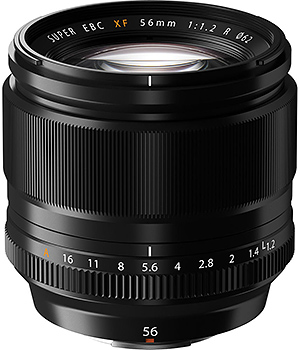
If your budget allows or if you really need a faster aperture lens, there are a handful of other higher-end portrait primes to pick from. In fact, it’s quite difficult to pick just one here to call out “Upgrade Pick.” If the $1000 market is your budgetary limit, one excellent option is the XF 56mm f/1.2 R. Offering a slightly longer ~85mm-equivalent focal length and a super-fast f/1.2 aperture, the 56mm prime is a supremely capable portrait prime. In our review, the lens tested surprisingly sharp at f/1.2, an uncommon feat for such a bright lens. Further, CA, vignetting, and distortion were all essentially a non-issue. Overall, the 56mm f/1.2 is a stunning optic.
Buy now: Amazon | B&H
Try It Before You Buy It? — Rent this lens from Lensrentals
Upgrade Pick: Fuji XF 90mm f/2 R LM WR

Another option would be the XF 90mm f/2. This longer 135mm-equivalent prime is incredibly sharp, even at f/2. Like supremely tack-sharp. The longer focal length can help create a more flattering appearance for your portrait subjects, while also allowing for beautiful telephoto compression and subjection isolation. The longer focal length does make it a little less versatile for everyday photo needs than our 50mm or 56mm picks, but if portraits are your main concern, it’s hard to do with this lens.
Buy now: Amazon | B&H
Try It Before You Buy It? — Rent this lens from Lensrentals
Upgrade Pick: Fuji XF 50mm f/1.0 R WR
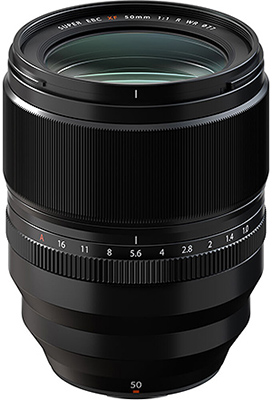
Now, normally, we would call it quits with two “Upgrade Picks” here, but we think we would be remiss not to call out the stunning XF 50mm f/1.0 lens. As you might imagine, this is a very uncommon lens — an autofocusing f/1.0 prime. It’s not super sharp wide open, though we don’t expect it to get tack-sharp given the extremely shallow depth of field and overall dreaminess that f/1.0 lenses can create. (It’s still pretty good in the center, but stopping down improves them greatly.)
However, images, especially portraits, shot at f/1.0 with this lens have a unique character that’s hard to overlook. You can capture some really interesting, dramatic images with a super-thin depth of field and creamy bokeh. With a price of $1500, the Fuji XF 50mm f/1.0 is certainly not budget-friendly, but it’s such a unique and impressive lens that we gave it an award in our 2020 Lens of the Year Awards.
Buy now: Amazon | B&H
Try It Before You Buy It? — Rent this lens from Lensrentals
Best Fujifilm Lens for Sports Photography
For sports photography, you’ll most likely want something telephoto, something with reach, to help bring the action up close. You’ll most likely not be able to get right up next to the sidelines, so a longer telephoto lens will be critical to getting pleasing, action-packed sports photos. Now, depending on the particular sport you’re photography, how much telephoto reach you’ll need can vary dramatically, but a classic go-to for many different popular sports, such as football, soccer, basketball, and tennis, is a 70-200mm lens — and a 70-200mm f/2.8 variety, if possible.
The zoom design of a 70-200mm lens provides excellent versatility for a variety of sports subjects, and the 200mm reach at the long end is a really solid telephoto focal length for distant subjects. An f/2.8 aperture, though not absolutely critical for every sports photography endeavor, helps in several ways, including more pleasing subject isolation (out-of-focus backgrounds) and simply letting more light into the lens. The latter will let you shoot with faster shutter speeds, helping you get crisp, blur-free action shots; plus, it will help if you need to shoot indoors or in other lower-light situations, letting you also shoot with a lower ISO setting (and thus less noise and grain).
First Choice: Fuji XF 50-140mm f/2.8 R LM OIS WR
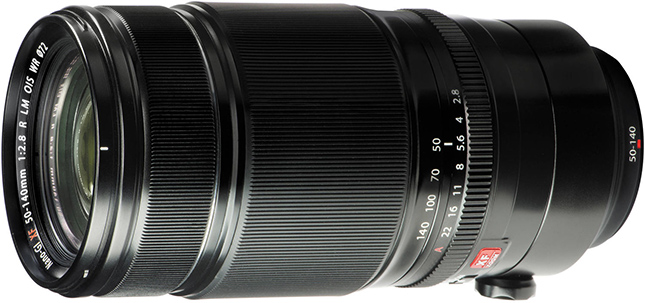
Unlike some of the other lens categories in this guide, when it comes to lenses for sports, the Fujifilm X-mount lens selection is fairly limited. Fuji does make a couple of affordable telephoto zooms with variable apertures that are more suitable for outdoor sports and wildlife pursuits. However, for that classic “70-200 f/2.8”-style lens, there’s really only one option: the XF 50-140mm f/2.8 R LM OIS WR.
Offering a versatile 75-225mm-equivalent zoom range paired with a bright and constant f/2.8 aperture, the XF 50-140mm f/2.8 is an ideal choice for many sports subjects, both indoors and out. The bright aperture allows for pleasing subject isolation and background blur, as well as making it easier to use the faster shutter speeds needed to stop fast action moments without raising ISO levels too high.
In our review, the XF 50-140mm f/2.8 proved to be a high-quality lens in all areas. Image quality was outstanding, with excellent sharpness wide open and throughout the zoom range. The build quality and design are also very nice, with thorough weather-sealing, good handling, and fast autofocusing. For those needing some additional versatility, the lens is also compatible with Fuji’s 1.4x and 2x teleconverters. Overall, this is a tried-and-true enthusiast and pro-level lens, and the pricing reflects that. But, as they say, you get what you pay for, and this lens should not let you down.
Buy now: Amazon | B&H
Try It Before You Buy It? — Rent this lens from Lensrentals
Upgrade Pick: Fuji XF 200mm f/2 R LM OIS WR

OK, bear with us here. This is a tricky lens to straight-up recommend, but if budget is absolutely of no concern, or you seriously want an absolute beast of a sports lens for your Fuji camera, look no further than the XF 200mm f/2 R LM OIS WR lens. Fuji’s first and so far only fast super-telephoto prime offers a long 300mm-equivalent focal length paired with a bright and wide f/2 aperture. Though useful for wildlife as well, this fast and bright lens is a no-brainer for sports subjects as well, especially field sports like soccer, football, and track-and-field, as well as motorsports.
We’ve gone hands-on with the lens, the Fuji XF 200mm f/2 is indeed a stunning lens. The lens is tack sharp focusing is swift, and it is capable of capturing amazing images. It’s a big, beefy lens, as you can imagine, weighing around 2265g (5 lbs.). Nonetheless, the lens is spectacular.
We mention it’s tricky to recommend this lens because the price tag of this optic is a whopping $6,000. That price is likely well outside the realm of affordability for many photographers. However, if you can afford such a lens, and you want the best (and so far only) super-telephoto prime for your Fujifilm X Series camera, this is it.
Buy now: Amazon | B&H
Try It Before You Buy It? — Rent this lens from Lensrentals
Best Fujifilm Lens for Wildlife Photography
Much like a lens for sports, you’re going to want a lens that offers a nice, longer telephoto focal length. In fact, in some cases, your “sports photography” telephoto lens can do double duty as a wildlife photography lens. That said, a 70-200mm-style lens may not be telephoto enough for wildlife photography, especially if you want to photograph birds. When choosing a proper wildlife-focused telephoto lens, finding something that reaches out to a least 300mm to 400mm is a good starting point. When photographing wildlife, you probably won’t be able to get very close to your subject, so having a long telephoto lens will allow you to bring that far-off subject up close.
Now, much like the other categories on this list, you also have a choice of prime (single focus length) or a zoom lens. Prime wildlife lenses can often be quite large and expensive, with some of the benefits there being fantastic optical quality and brighter apertures, which let them perform in lower light and have a gorgeous shallow depth of field. That said, it’s hard to look past the versatility of a zoom lens, which is why we’re focusing on zoom lenses here for our recommendations.
First Choice: Fuji XF 100-400mm f/4.5-5.6 R LM OIS WR
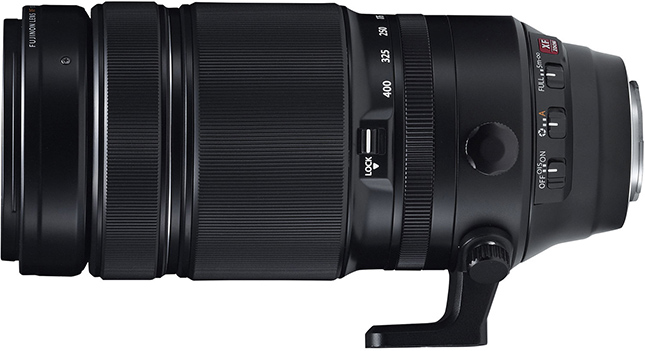
When it comes to super-telephoto lenses for wildlife purposes, the selection for Fuji cameras is similar to that for sport-focused lenses, limited. However, fortunately, there is one excellent super-telephoto zoom lens that fits the bill for wildlife photography quite nicely: the Fujifilm XF 100-400mm f/4.5-5.6 R LM OIS WR. Fuji’s longest-reaching zoom lens is an ideal wildlife lens, offering a 150-600mm-equivalent zoom range, as well as robust weather sealing, built-in optical image stabilization, and fast autofocusing performance. The highly versatile zoom range makes it an ideal lens for all sorts of wildlife subjects, from large animals to far-off birds. Plus, the lens is compatible with teleconverters for even more reach, if needed (though beware that the apertures can become quite dim once you add the extenders).
Optically, the Fuji 100-400mm is very good across its zoom range, though it does get ever-so-slightly softer past the 300mm mark — though not to a significant degree. It’s quite a large lens, but it’s built well and handles nicely on larger Fuji cameras, such as the X-T4. All in all, it’s a fantastic wildlife lens and earned an award for Lens of the Year, and Best Telephoto Zoom in 2016.
Buy now: Amazon | B&H
Try It Before You Buy It? — Rent this lens from Lensrentals
Upgrade Pick: Fuji XF 200mm f/2 R LM OIS WR + XF 1.4X TC F2 WR Kit
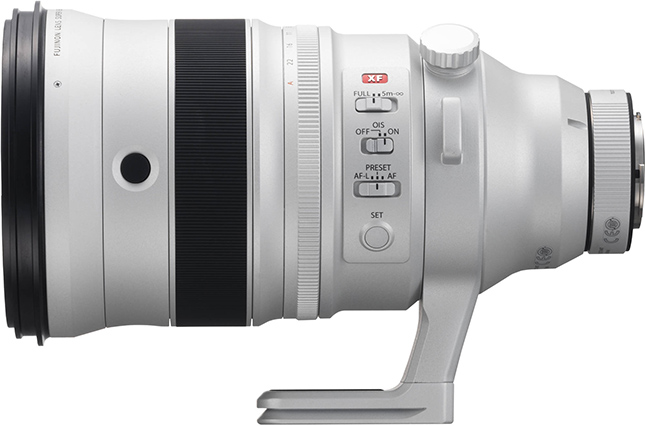
And here we are again with the expensive XF 200mm f/2 lens. Not only is it a solid choice for sports, but it can also do very well for wildlife photography, thanks to its compatibility with teleconverters. In fact, Fujifilm sells the lens bundled with a 1.4x teleconverter that, when put together, creates a lens with a 427mm-equivalent focal length — an excellent wildlife range. Though expensive, this lens is amazingly sharp and will capture stunning images. If you can afford it.
Buy now: Amazon | B&H
Try It Before You Buy It? — Rent this lens from Lensrentals
Best Fujifilm Lens for Macro Photography
For macro photography, one of the main characteristics to look for is a lens’s close-focusing capabilities, or “minimum focusing distance.” You want a lens that can focus very closely on a subject and still maintain crisp focus. Generally, a lens that is labeled as a “macro lens” offers a magnification factor of at least 1.0x, or a 1:1 magnification ratio. In other words, for a 1:1 macro lens at the closest focusing distance, the subject captured in the frame will be the same size as in the real world. There are other flavors of macro lenses, some with half-size (1:2) magnification ratios as well as more powerful lenses that offer 2:1 or even 5:1 magnification ratios for larger-than-life-size macro photography.
The macro category is one of the few areas here for Fujifilm cameras where there are some high-quality options from third-party manufacturers, especially if you’re okay with manual focus-only lenses.
First Choice: Fuji XF 60mm f/2.4 R Macro
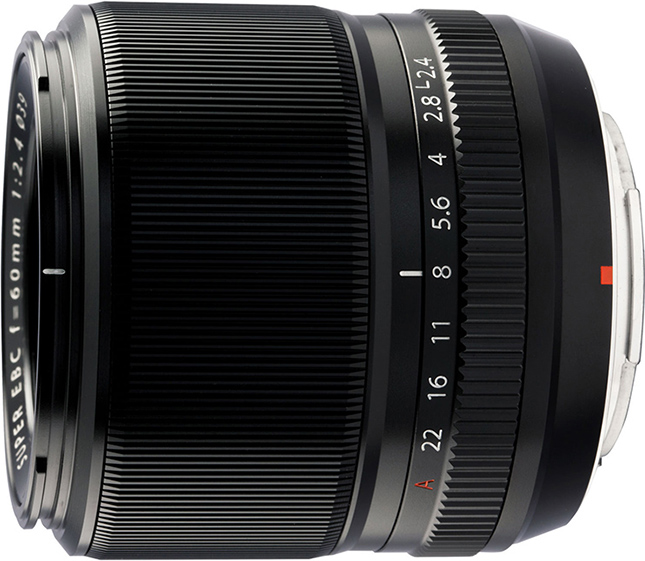
If you want to stick to Fujifilm for your macro lens needs, a solid choice to get you started is the XF 60mm f/2.4 R Macro lens. It’s not a 1:1 macro lens, however, but instead is a half-macro or 1:2 (0.5x) lens, capturing images with subjects at half their size. Still, it can focus extremely closely and offers fantastic image quality performance. Wide-open sharpness is very impressive, but as you stop down, image quality remains extremely good. When shooting macro images, you’ll often need to stop down significantly in order to have sufficient depth of field for your subjects, and having a sharp performance at really narrow apertures is great to see. The Fuji 60mm f/2.4 Macro is also small and lightweight, making it easy to carry around and shoot handheld — though it does lack image stabilization, which can be helpful for macro shooting.
Buy now: Amazon | B&H
Try It Before You Buy It? — Rent this lens from Lensrentals
Alternative Option: Venus Optics Laowa 65mm f/2.8 2x Ultra Macro

However, if you don’t mind manual focus, an exciting macro option would be the Venus Optics Laowa 65mm f/2.8 2x Ultra Macro. This small, manual lens costs just $400 and yet provides sharp images and impressive 2x macro capabilities. The optical design allows for larger-than-life-size 2:1 macro magnification.
We’ve not yet gone hands-on with this particular lens, though we’ve seen and field-tested a few other Laowa lenses in the past, and we’ve been quite impressed. User reviews of the Laowa 65mm f/2.8 2x Ultra Macro lens are all overwhelmingly positive, with owners praising its excellent sharpness and low price.
Buy now: Amazon | B&H
Try It Before You Buy It? — Rent this lens from Lensrentals
Upgrade Pick: Zeiss Touit 50mm f/2.8M Macro

If you have more budget to allot for your macro lens, a solid option is the Zeiss Touit 50mm f/2.8M Macro lens. This solidly built yet surprisingly lightweight 75mm-eq. Zeiss lens offers autofocus capabilities and full 1:1 macro magnification. While we’ve not yet reviewed this particular Zeiss lens, the company has a history of making excellent optics, and user reviews of this 50mm macro lens are all exceedingly positive. Users heap praise on the lens’s excellent sharpness and overall image quality. At around $1000, the lens is certainly in pricey territory. The lens also lacks a focusing limiter switch, nor does it offer optical image stabilization.
Buy now: Amazon | B&H
Try It Before You Buy It? — Rent this lens from Lensrentals
Upgrade Pick: Fuji XF 80mm f/2.8 R LM OIS WR Macro
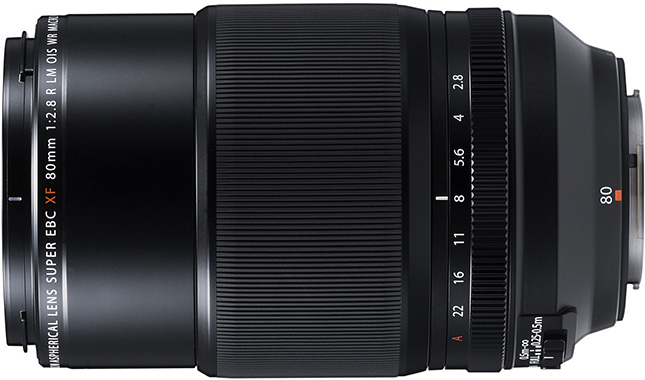
Lastly, if you’d like to stick with a Fujifilm-made option for your “Upgrade Pick,” look no further than the XF 80mm f/2.8 R LM OIS WR Macro. The XF 80mm Macro is Fuji’s first and so far only 1:1 macro lens for X-mount, and it also comes with all the bells and whistles you’d expect from a top-of-the-line macro lens: autofocus, built-in optical image stabilization, weather sealing and a focus limiter switch. The 80mm focal length provides a handy 120 mm eq. focal length, which paired with the f/2.8 aperture, can make the lens also useful for portraits or other subjects where you want a nice, shallow depth of field look.
Based on our field test and other user reviews, the XF 80mm earns high marks for image quality. Images are extremely sharp, even at f/2.8. The lens also does while stopped down, which is important for macro shooting. There really isn’t much to complain about with this lens, especially in terms of image quality. AF can get sluggish when shooting at macro distances, and the lack of a tripod foot is also a bit disappointing given the lens’s heft. Overall, if budget is less of a concern, the Fuji 80mm f/2.8 Macro lens is a fantastic lens.
Buy now: Amazon | B&H
Try It Before You Buy It? — Rent this lens from Lensrentals
Best Fujifilm Lens for Astrophotography
When it comes to photographing the night sky, astrophotography isn’t really tied to any one focal length, technically. However, oftentimes, you want to capture a broad, expansive view of the night sky, stars, galaxies, and the like. To do that, one needs a wide-angle or ultra-wide-angle lens, something very short, often less than 24mm, in order to capture a wide perspective. Additionally, another key factor for a good astrophotography lens is a wide or bright maximum aperture — the brighter, the better in order to gather as much light as possible and keep the ISO levels down as much as possible. So while astrophotography compositions can come in all sorts of framing and perspectives, we’re going to recommend a couple more common types of lenses: ultra-wide-angle lenses with bright apertures.
First Choice: Fuji XF 14mm f/2.8 R
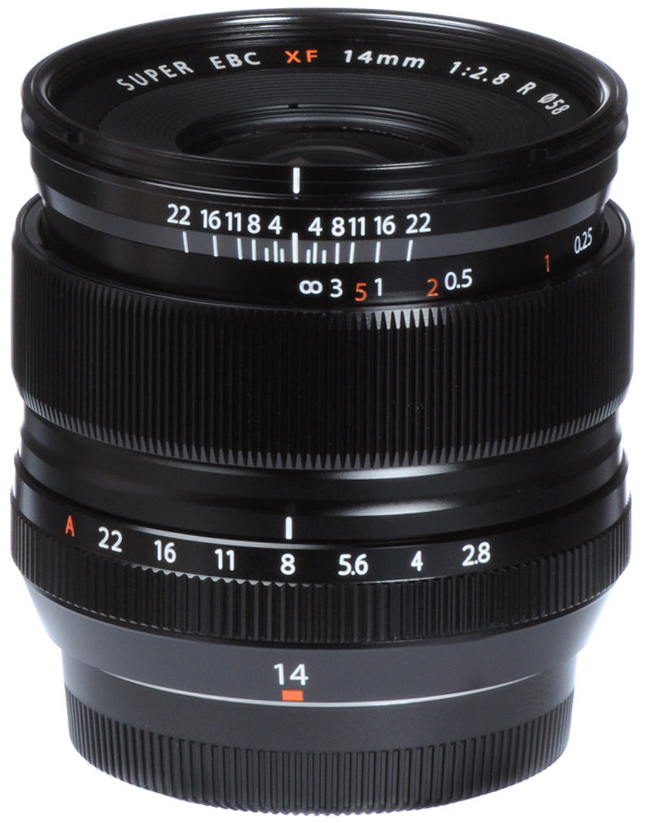
Offering both an ultra-wide perspective and a bright, light-gathering aperture, our first pick for an X-mount astrophotography lens is the Fuji XF 14mm f/2.8 R. One of the older lenses in Fuji’s X-mount lineup, the compact 14mm prime is a solid, sharp choice not only for Astro purposes but also broad general landscapes as well. The lens’s 21mm-equivalent focal length is perfect for vast, eye-catching night-sky scenes, and the lens also does very well against optical aberrations, particularly comatic aberration.
In our review, we noted the lens’s excellent image quality performance. Sharpness is fantastic, even wide-open (though there is some corner softness at f/2.8). Meanwhile, CA and distortion are of little concern, as is vignetting for the most part. Overall, the tiny 14mm f/2.8 prime is a wonderful choice for both astro and landscapes.
Buy now: Amazon | B&H
Try It Before You Buy It? — Rent this lens from Lensrentals
Alternative Option: Rokinon 12mm f/2 NCS CS
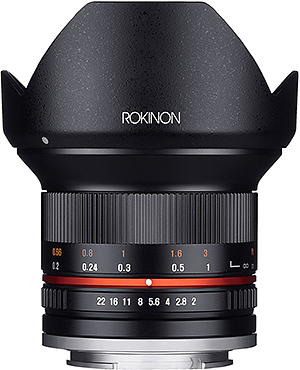
However, if you don’t mind a non-Fujifilm lens and are okay with manual focus-only, one of the most enticing options for an astrophotography lens is the $330 Rokinon 12mm f/2 prime. Offering a super-wide 18mm-eq. focal length and a bright f/2 aperture, the Rokinon 12mm f/2 is a no-brainer for astrophotographers. We have not had the chance to review this particular Rokinon lens ourselves, but owners and other user reviews praise the lens’s sharpness. Image quality is excellent across the aperture range, making it excellent for all sorts of wide-angle photography pursuits. In particular, coma, even at f/2, is essentially a non-issue. All in all, this tiny manual focus lens an amazing value and an excellent lens for an astrophotography setup on a budget.
Buy now: Amazon | B&H
Upgrade Pick: Fuji XF 8-16mm f/2.8 R LM WR

For our upgrade pick here, we have to once again select the excellent Fuji XF 8-16mm f/2.8. Extremely sharp and very versatile with a range of astrophotography-friendly focal lengths plus a bright f/2.8 aperture all combine to make this high-end lens an excellent pick for night-sky photography. As mentioned earlier, the image quality is outstanding, and the lens does a very good job of suppressing comatic aberration. A bit pricey and a bit heavy, but the XF 8-16mm f/2.8 is an all-around fantastic ultra-wide zoom lens that’s a solid choice for landscapes, both during the day and at night.
Buy now: Amazon | B&H
Try It Before You Buy It? — Rent this lens from Lensrentals









